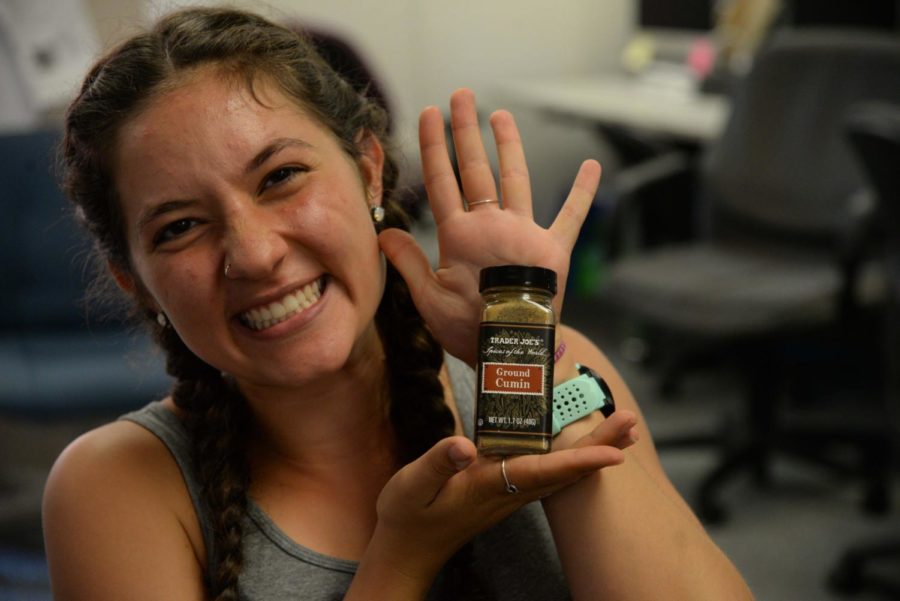Opinion | An ode to my one and only true love
Hannah Heisler | Senior Staff Photographer
Assistant Opinions Editor Leah Mensch really likes cumin.
September 25, 2019
Editor’s note | This column was originally mislabeled as opinion. It was written intentionally as satire.
In between the Tigris and Euphrates valleys, fertile with rich soil, sunshine and fresh air, aromatic plants sprouted from the ground. On Sumerian clay tablets, the ancient Mesoptomians recorded their revolutionary spice and herb use. Thyme, sesame, cardamom, turmeric, saffron, poppy, garlic, cumin, anise, coriander, silphium, dill and myrrh — they used it all in abundance.
In the summer of 720 B.C. — approximately — Babylonian King Merodach-baladan II grew the spices and herbs in his royal garden, taking careful note of how to perfect the art of harvesting. Since then, these spices have become staples in cuisine internationally.
King Merodach-baladan II never made specific note of his favorite spice on his stone tablet, as far as historians are aware. He had other business to attend to. Besides, the best spice was as evident back then as it is now — cumin.
My love affair with the golden yellow powder started in grade school. Unlike many other romantic relationships in my life, my love for it has only grown stronger over time. Cumin is dedicated and faithful. It’s been around since 700 B.C. and adapts to most circumstances — the spice isn’t going anywhere.
Cumin graces our taste buds today in a plethora of Mexican dishes. Some of its most frequent appearances are in chile con carne and hot tamales. But its slightly bitter, beautifully warm flavors actually come from a land far from Mexico, contrary to popular belief.
The spice is native to the shores of the Mediterranean Sea and the gardens within Egypt, Iran and India. Its essence originated in many Middle Eastern foods and is still a staple in these cultures today. But the seed of the Cuminum cyminum — a small herb in the parsley family — can adapt to almost any climate, which is yet another reason why this versatile spice is so fabulous.
For lovers of cumin, it can be difficult not to resent those who think cumin to be only a Mexican spice, ignoring its origins and deep, rich history. But the increasing popularity of Mexian influenced foods, including cumin, has increased the sale of cumin. It has introduced more people to the spice, and thus, I have nothing but thanks to give those who only eat cumin in Mexican food.
In terms of its greatness, one must not forget the many health benefits of the delicious spice. Consumption of cumin is linked to improved digestion. In a 2013 Journal of Digestive Diseases study, 57 patients with irritable bowel syndrome reported improved symptoms after taking concentrated cumin for two weeks. It’s also an incredibly rich source of iron, even in small amounts. Ten million adults in the United States are iron deficient, and just one teaspoon contains almost a fourth of the recommended daily iron intake for adults.
Some studies even suggest that cumin may also help with diabetes, improve blood cholesterol, prevent food borne illness and fight drug dependence. It’s highly likely that none of these things are actually true, but who knows? It’s a beautiful thing to imagine and just another reason this spice is magical.
Part of this magic is cumin’s versatility. It complements more than just Indian, Middle Eastern and Mexican cuisine. Cumin has been adapted to enhance a wide range of recipes. Cumin cookies, for example, made it onto the New York Times cooking page, and have accumulated an impressive rating — more than four stars. To name a few of the many dishes, people glaze ribs in cumin, use the spice in salad dressing and broiled shrimp.
It also serves as my cooking Band-Aid, which is to say that when I mess up a recipe, I just dump cumin into it until it tastes decent again. The strength of the spice is quite powerful and can make almost any bad dish at least moderately edible. Really, though, this spice is just delicious. Both the smell and the taste are unmatched — which is why there are retailers of cumin-scented candles. Even Jesus enjoyed it. Cumin is mentioned in both the Old Testament and the New Testament of the Bible.
There is no substitute for cumin, no spice that shares all of its unique and beautiful qualities. It is not Old Bay Seasoning, which has only been around for 75 years and is not a rich source of iron. It is not “taco seasoning,” as someone once dared say to me. It is a delicious ingredient in taco seasoning, potentially, but it is not to be confused with a packet of Old El Paso from Target. It is its own entity. And that’s why it’s timeless, versatile and unbeatable.
My love for cumin knows no bounds and recognizes no limits. I would fight to the end for this spice and its top spot on the spice hierarchy, though of course I don’t need to. It exemplifies its excellence all on its own.
Leah Mensch is the assistant opinions editor at The Pitt News. She writes mostly about mental health, books and the spices of the world. Write to Leah at LEM140@pitt.edu.




